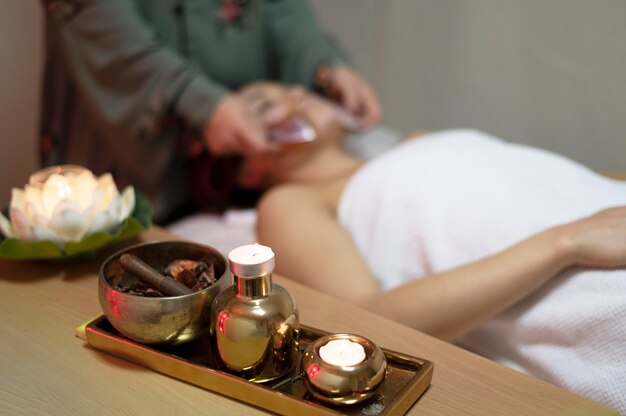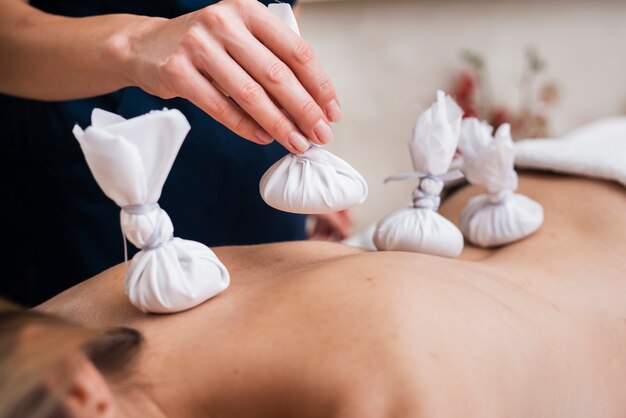आयुर्वेदिक डॉक्टर से प्रश्न पूछें और निःशुल्क या भुगतान मोड में अपनी चिंता की समस्या पर ऑनलाइन परामर्श प्राप्त करें। 2,000 से अधिक अनुभवी डॉक्टर हमारी साइट पर काम करते हैं और आपके प्रश्नों का इंतजार करते हैं और उपयोगकर्ताओं को उनकी स्वास्थ्य समस्याओं को हल करने में प्रतिदिन मदद करते हैं।
अभी हमारे स्टोर में खरीदें
Kala Basti: Ayurvedic Insights & Modern Perspectives

Introduction: A Striking Look into Kala Basti
Imagine a holistic treatment that not only claims to detoxify the body but also aligns with ancient medicinal principles dating back thousands of years. Kala Basti—an Ayurvedic procedure recognized within the broader umbrella of Panchakarma therapies—has been garnering attention as a potential natural approach to digestive wellness and systemic balance. While firmly rooted in classical Ayurvedic texts like the Charaka Samhita and Sushruta Samhita, Kala Basti’s relevance is also being examined in modern medical research settings. This article aims to demystify the practice of Kala Basti from both a traditional and scientific perspective, offering a balanced, research-based overview of its methodology, potential benefits, and limitations.
Disclaimer: The information provided here is for educational purposes only. It does not substitute professional medical advice, diagnosis, or treatment. Always consult a qualified healthcare provider before incorporating any new therapy or treatment regimen.
Table of Contents
-
What Is Kala Basti?
-
Historical and Cultural Roots
-
The Science Behind Kala Basti
-
Procedure and Protocol
-
Research Evidence and Clinical Findings
-
Potential Benefits and Applications
-
Possible Risks and Contraindications
-
Practical Tips for Real-World Application
-
Frequently Asked Questions (FAQ)
-
Summary and Key Takeaways
1. What Is Kala Basti?
In Ayurveda, the term “Basti” generally refers to therapeutic enemas that aim to detoxify and restore balance in the body’s doshas—primarily Vata, but also Pitta and Kapha under certain circumstances. Kala Basti is one specialized regimen within the broader spectrum of Basti treatments, characterized by a specific sequence and number of enema sessions (often 16 in classical regimens).
Core Principle: According to Ayurvedic theory, Vata dosha governs movement, communication, and the nervous system. By delivering specially formulated herbal preparations via enema, Kala Basti is believed to remove accumulated toxins (known as ama in Ayurveda) and recalibrate bodily functions.
LSI Keywords and Synonyms
-
Ayurvedic detox
-
Panchakarma therapy
-
Therapeutic enema
-
Vata dosha cleansing
-
Herbal bowel cleansing
2. Historical and Cultural Roots
Kala Basti’s origins trace back to classical Ayurvedic texts, where Basti was lauded as a primary means for disease management, especially for ailments connected to Vata imbalance. Historically:
-
Charaka Samhita (circa 1000 BCE): Describes various Basti formulations, emphasizing the importance of correct dosage, timing, and sequence.
-
Sushruta Samhita (circa 600 BCE): Mentions enema therapies in surgical and post-surgical care to expedite recovery and promote internal cleansing.
-
Ashtanga Hridayam: Further classifies Basti into different types, detailing their roles in both preventive and curative healthcare strategies.
Across centuries, Kala Basti remained part of Panchakarma, the fivefold detox system in Ayurveda, which also includes Vamana (therapeutic emesis), Virechana (purgation), Nasya (nasal therapy), and Raktamokshana (bloodletting). Kala Basti’s longstanding use in India and increasing global interest highlight its enduring cultural significance.
3. The Science Behind Kala Basti
Modern medicine is progressively exploring how enemas with medicated oils or decoctions may influence gut microbiota, inflammatory pathways, and neurological signals. While research on Kala Basti specifically is still emerging, general insights on therapeutic enemas provide clues to its mechanisms:
-
Gut Microbiome: A 2019 review in the Journal of Integrative Medicine noted that some herbal enemas could positively modulate gut flora, potentially impacting immune function and gastrointestinal health 11.
-
Inflammatory Response: Certain herbal compounds exhibit anti-inflammatory properties, as detailed in a 2020 systematic review in Phytotherapy Research. When administered rectally, these compounds may reduce local and systemic inflammation.
-
Neurological Pathways: The enteric nervous system (often termed the “second brain”) communicates with the central nervous system. By impacting the gut environment, therapeutic enemas could theoretically influence mood and stress levels, although more high-quality studies are required to confirm these effects.
Key Point: While modern clinical trials on Kala Basti remain limited, preliminary findings on herbal enemas suggest potential benefits in digestive regulation and stress management. However, robust, large-scale studies are needed for conclusive evidence.
4. Procedure and Protocol
Although specifics can vary between Ayurvedic practitioners, the general framework for Kala Basti includes:
-
Preliminary Phase (Purva Karma)
-
Diet Modification: Patients are advised to consume light, easily digestible foods a few days prior.
-
Oil Massage (Abhyanga): Warm herbal oils are applied to the body to loosen toxins.
-
Steam Therapy (Swedana): Mild steaming helps open pores and channels, facilitating toxin mobilization.
-
-
Main Phase (Pradhana Karma)
-
Number of Basti Sessions: Traditionally, 16 enemas are administered in a specific sequence—often alternating between oil-based enemas (Anuvasana Basti) and decoction-based enemas (Niruha Basti).
-
Formula Preparation: Herbal decoctions, oils, ghee, or milk may be used, depending on the patient’s constitution and condition.
-
Administration: The solution is gently introduced into the rectum using a sterile apparatus, and the patient is advised to retain it for a prescribed duration, which can range from a few minutes to half an hour, depending on the formulation.
-
-
Follow-up Phase (Paschat Karma)
-
Dietary Guidelines: Light, warm, and nutritive foods are recommended post-therapy to rebuild digestive fire (agni).
-
Rest and Recuperation: Patients are advised to rest, avoid strenuous activity, and gradually return to their normal routine.
-
5. Research Evidence and Clinical Findings
Peer-reviewed evidence on Kala Basti specifically is comparatively scarce; however, several studies on similar Ayurvedic enemas and protocols offer relevant insights:
-
Study on Panchakarma Efficacy (2018, Journal of Ayurveda and Integrative Medicine): Found that Basti therapy, when combined with dietary changes, could improve symptoms of chronic constipation and reduce bloating in a small cohort of participants 22.
-
Meta-Analysis of Herbal Enemas (2020, Complementary Therapies in Medicine): This paper analyzed multiple forms of herbal enemas and noted potential for managing certain inflammatory bowel conditions, but called for more rigorous, larger-scale trials 33.
Experts from institutions like the Central Council for Research in Ayurvedic Sciences (CCRAS) in India recommend pursuing randomized controlled trials to better understand the clinical efficacy, safety profile, and long-term benefits of Kala Basti.
6. Potential Benefits and Applications
Based on Ayurvedic theory and preliminary scientific insights, practitioners often recommend Kala Basti for:
-
Digestive Health: Chronic constipation, bloating, and irregular bowel movements.
-
Joint and Musculoskeletal Issues: Conditions like lower back pain or arthritis, believed to be linked to Vata imbalance.
-
Nervous System Support: Stress, anxiety, and certain neurological concerns may benefit from improved gut-brain axis regulation.
-
Holistic Detoxification: Combined with diet and lifestyle interventions, it’s posited to help clear metabolic waste (ama).
Note: While many individuals report subjective improvements, these benefits should be interpreted with caution, and further clinical validation is essential.
7. Possible Risks and Contraindications
Like any medical procedure, Kala Basti is not universally suitable. Possible risks and contraindications include:
-
Severe Gastrointestinal Conditions: Rectal bleeding, acute hemorrhoids, or inflammatory bowel disease flares.
-
Chronic Diseases: Patients with complicated comorbidities (e.g., advanced diabetes, cardiac issues) should consult a healthcare provider.
-
Immediate Post-Surgery: Enema procedures might interfere with surgical recovery, requiring specialized medical advice.
-
Allergies: Potential reactions to certain herbal components.
Important: A qualified Ayurvedic practitioner typically evaluates an individual’s constitution (Prakriti) and current imbalances (Vikriti) to determine whether Kala Basti is appropriate.
8. Practical Tips for Real-World Application
Should you decide to explore Kala Basti under professional guidance, consider these best practices:
-
Consult Your Doctor: Always discuss your medical history with both an Ayurvedic specialist and a licensed physician.
-
Check Credentials: Ensure the practitioner is well-trained and certified in Panchakarma therapy.
-
Follow Preparatory Guidelines: Adhering to recommended dietary and lifestyle modifications can enhance the therapy’s effectiveness.
-
Ask About Sterility: Verify that sterile equipment and hygienic conditions are maintained to reduce infection risk.
-
Stay Hydrated: Drink adequate water before and after the therapy to support detoxification processes.
9. Frequently Asked Questions (FAQ)
Q1. Is Kala Basti painful?
Most people experience mild discomfort or cramping during the administration but not significant pain. The key is to follow the practitioner’s instructions on breathing and relaxation techniques.
Q2. How many sessions are needed?
Traditionally, Kala Basti involves 16 sessions. However, the exact number may vary based on individual needs, the practitioner’s assessment, and specific health goals.
Q3. Can I do Kala Basti at home?
Given its complexity and need for sterilization, self-administration is generally discouraged. Professional supervision ensures safety and appropriate formulation.
Q4. How soon can I expect results?
Some individuals notice immediate relief from constipation or a sense of lightness, while deeper systemic improvements may take multiple sessions and ongoing lifestyle adjustments.
Q5. Are there alternatives if I cannot undergo Kala Basti?
Yes. Alternatives include dietary modifications, herbal supplements, and other Panchakarma therapies like Virechana (therapeutic purgation) or Nasya (nasal therapy). Always seek professional advice.
10. Summary and Key Takeaways
Kala Basti stands as a fascinating intersection between ancient Ayurvedic wisdom and modern integrative healthcare. Rooted in time-tested traditions of detoxification and restorative healing, this specialized therapeutic enema protocol targets Vata imbalance, aiming to support digestive function, neurological well-being, and holistic detoxification. While early research and anecdotal evidence are promising, robust, large-scale clinical trials remain necessary to substantiate many of the claims.
In summary:
-
Kala Basti is deeply rooted in Charaka Samhita and Sushruta Samhita, highlighting its long history.
-
Modern science is beginning to explore therapeutic enemas for gut health and inflammation.
-
Proper preparation, qualified supervision, and post-therapy care are crucial for safety and efficacy.
-
Further research is essential to validate its broad-ranging benefits and clinical applications.
Call to Action
If you found this article helpful, feel free to share it with friends or colleagues interested in holistic health solutions. For more insights into Ayurvedic therapies and evidence-based wellness strategies, subscribe to our newsletter and stay updated on the latest research findings. Your journey to balanced health may just begin with exploring the art and science behind time-honored treatments like Kala Basti.
References
-
Journal of Integrative Medicine, 2019; 17(3) -
Journal of Ayurveda and Integrative Medicine, 2018; 9(2) -
Complementary Therapies in Medicine, 2020; 52
Disclaimer: This article is intended to provide general information about Kala Basti from an Ayurvedic and scientific perspective. It should not be construed as medical advice or used as a substitute for consultations with qualified healthcare professionals. Always seek personalized guidance to determine the right course of treatment for your specific condition.
यह लेख वर्तमान योग्य विशेषज्ञों द्वारा जाँचा गया है Dr. Harsha Joy और इसे साइट के उपयोगकर्ताओं के लिए सूचना का एक विश्वसनीय स्रोत माना जा सकता है।




